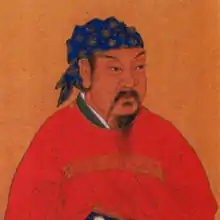422
Year 422 (CDXXII) was a common year starting on Sunday (link will display the full calendar) of the Julian calendar. At the time, it was known as the Year of the Consulship of Honorius and Theodosius (or, less frequently, year 1175 Ab urbe condita). The denomination 422 for this year has been used since the early medieval period, when the Anno Domini calendar era became the prevalent method in Europe for naming years.
| Millennium: | 1st millennium |
|---|---|
| Centuries: | |
| Decades: | |
| Years: |
| 422 by topic |
|---|
| Leaders |
|
| Categories |
|
| Gregorian calendar | 422 CDXXII |
| Ab urbe condita | 1175 |
| Assyrian calendar | 5172 |
| Balinese saka calendar | 343–344 |
| Bengali calendar | −171 |
| Berber calendar | 1372 |
| Buddhist calendar | 966 |
| Burmese calendar | −216 |
| Byzantine calendar | 5930–5931 |
| Chinese calendar | 辛酉年 (Metal Rooster) 3118 or 3058 — to — 壬戌年 (Water Dog) 3119 or 3059 |
| Coptic calendar | 138–139 |
| Discordian calendar | 1588 |
| Ethiopian calendar | 414–415 |
| Hebrew calendar | 4182–4183 |
| Hindu calendars | |
| - Vikram Samvat | 478–479 |
| - Shaka Samvat | 343–344 |
| - Kali Yuga | 3522–3523 |
| Holocene calendar | 10422 |
| Iranian calendar | 200 BP – 199 BP |
| Islamic calendar | 206 BH – 205 BH |
| Javanese calendar | 306–307 |
| Julian calendar | 422 CDXXII |
| Korean calendar | 2755 |
| Minguo calendar | 1490 before ROC 民前1490年 |
| Nanakshahi calendar | −1046 |
| Seleucid era | 733/734 AG |
| Thai solar calendar | 964–965 |
| Tibetan calendar | 阴金鸡年 (female Iron-Rooster) 548 or 167 or −605 — to — 阳水狗年 (male Water-Dog) 549 or 168 or −604 |

Emperor Wu of Liu Song (420–422)
Events
Roman Empire
- End of the Roman–Sassanid War: Emperor Theodosius II signs a 100-year peace treaty with Persia after 2 years of war. He agrees to a status quo ante bellum ("the state in which things were before the war"), and both parties guarantee liberty of religion in their territories.
- March 3 – Theodosius II issues a law to form provisions in peacetime. He instructs landowners leasing towers in the Theodosian Walls to assist with the build-up of emergency goods. Theodosius pays an annual tribute of 350 pounds of gold to the Huns in order to buy peace.[1]
- Theodosius II receives a statue at Hebdomon, military parade ground on the shores of the Propontis, just outside Constantinople. On its base (fragments are now in the Istanbul Archaeology Museum), an inscription praises him as “everywhere and forever victorious.”
- The walls of Rome's Flavian Amphitheater (Colosseum) crack during an earthquake.[2]
Europe
Asia
- Shao Di, age 16, eldest son of Wu Di, succeeds his father as emperor of the Liu Song Dynasty (China).
Art
- Petrus, bishop of Illyria, starts construction of the Church of Santa Sabina (approximate date).
Religion
- September 4 – Pope Boniface I dies after a 4-year reign that was interrupted for 15 weeks, by the faction of the antipope Eulalius. He is succeeded by Celestine I as the 43rd pope.
- Approximate date – A monastic community is established at the Maijishan Grottoes.[4]
Births
- August 8 – Casper, ruler of the Maya city of Palenque
- Genevieve, patron saint of Paris (approximate date)
- Licinia Eudoxia, Roman empress (d. 493)
Deaths
References
- The End of Empire (p. 87). Christopher Kelly, 2009. ISBN 978-0-393-33849-2
- "Colosseum". World History Encyclopedia. Retrieved September 27, 2020.
- MacDowall, Simon (2018). The Franks. London: Grub Street Publishers. p. 19. ISBN 978-1-4738-8960-6.
- Memoirs of Eminent Monks.
This article is issued from Wikipedia. The text is licensed under Creative Commons - Attribution - Sharealike. Additional terms may apply for the media files.